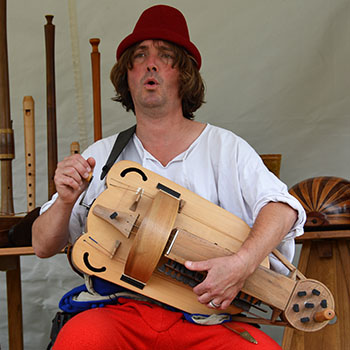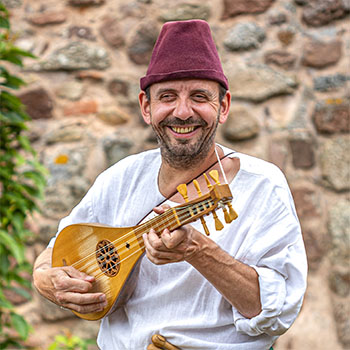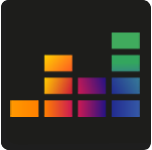It is a scenic exhibition of about a hundred of our instruments copied from old ones.
It covers all families of instruments from the medieval period: wind instruments (aerophones, woodwind and brass instruments), string instruments (bowed strings, plucked strings, struck strings) not forgetting percussion instruments and other idiophones.
We can add to it concerts-conferences on medieval organology.
You will find below a description of our medieval instruments.
Some of our medieval musical instruments


Medieval bagpipes
Although the principle of a wind-instrument attached to a sack (tibia utricularis) was mentioned as early as Roman antiquity, no precise images or descriptions of this period have been discovered yet.
It is only after the first crusades that definite clear attestations of bagpipes in Western Europe have been found. During the 12th and 13th centuries, they gradually gained ground in varied local forms.
Their shapes and sizes differ. They can be fitted with single or double reeds and with one or more drones if there are any (a drone is a pipe with a reed producing a unique and constant buzzing sound which supports and amplifies the melody). Bagpipes can produce either a soft and soothing sound or a powerful and piercing sound.
All bagpipes have at least a chanter (melodic pipe) supplied with air by a leather bag which allows the musician to catch his breath without stopping the sound once it is inflated.
Medieval iconography often depicts bagpipes as instruments played by shepherds or angels.


Medieval hurdy-gurdies
The wheel of this instrument, on which the strings are stretched, is rotated by a hand crank that makes the strings vibrate. This wheel thus plays the role of a “constant bow” which allows the hurdy-gurdy to produce a continuous sound.
Some of these strings produce a single note which supports the melody; they are called “drone strings”. The “melody strings” are associated with the keyboard which allows modifying the vibrating length. They are used to play the melody.
In the late Middle Ages, the hurdy-gurdy benefits from an improvement that revolutionised its use : a new drone string is mounted on a small buzzing bridge that vibrates and produces rhythmic crackles based on the jerks applied by the musician to the crank. The hurdy-gurdy was first mentioned in the 10th or 11th century as the organistrum, a large instrument that required two people to be played, one who turned the crank while the other played the keyboard. It quickly fell into disuse to evolve towards smaller instruments that required only one musician. At the end of the Middle Ages, the hurdy-gurdy in its various forms became the traveling companion of beggars.


Portative organs, also known as “Organetti”
This small organ appeared in the 12th century. It was used to accompany vocal works in monasteries but was not exclusively associated with the liturgy. The organetto is often played in festive events.
With one hand, the performer operates a bellows that supplies the instrument with air. He uses his other hand to play on a keyboard on which each key is associated with a valve releasing the air towards the foot of one of the flue pipes to make it vibrate and produce a note.
The organetto was widely popular in the 14th and 15th centuries, before falling into disuse after competing with the positive organ which was larger but still transportable. In the iconography, Saint Cecilia is often portrayed playing this instrument which is also often depicted in the hands of angel musicians. It is represented on the tombstones of the virtuoso organists such as Francesco Landini (14th century) in Florence and Conrad Paumann (15th century) in Munich.


Medieval lutes
It was the king instrument of the late Middle Ages. The lute is a plucked string instrument with a rounded body and is known to be of oriental origin. Its introduction in Europe during the 9th century is attributed to Zyriab, master of Arab-Andalusian music. The Crusades later also fostered the spread of the instrument.
Its deep rounded body is generally made by joining and gluing together thin strips of wood called ribs.
In the Middle Ages, the lute was essentially played with a plectrum. But around 1500 a new technique was developed: fingerpicking. This technique made the lute polyphonic and it became, therefore, a respected instrument used in art music.
The gittern is a small lute. Its body, neck, and bent pegbox, which is often adorned with a sculpted head, were carved from one piece of timber. It is played with a plectrum. It’s a popular instrument, often played in taverns.


Nyckelharpas
This bowed string instrument of Scandinavian origin is equipped with a keyboard similar to the hurdy-gurdy’s. Its keys are attached to small pieces of wood (called “tangents”) which stop the strings from moving so as to get the desired note’s pitch.
The existence of this keyed fiddle (translated from Swedish “Nyckelharpa”) is attested as early as the 14th century: a depiction of the instrument dating back from 1350 can be seen on a capital of the church of Källunge (Gotland Island, Sweden).
In the Middle Ages, the nyckelharpa had few strings and its keyboard had only one row of keys. It has improved a lot over the years, its keyboard has now up to four rows of keys and sympathetic strings increase the resonance.
Because of its typical cathedral-like sound, it is still widely used for the interpretation of the traditional Swedish repertoire. It is a versatile instrument that is increasingly played by early music ensembles.
Our luthier friends

Lutes, gitterns, citoles
Florian Jougneau : https://florianjougneau.com/
Ugo Casalonga : https://www.casa-liutaiu.com
Marco Salerno : www.marcosalerno.it/
Didier Jarny : https://www.luths-et-luthier.com/
Nyckelharpas
Jean-Claude Condi : http://www.nyckelharpa-condi.com/
Olle Plahn : http://www.tongang.se/olle/olle/welcome.html
Portative organs
Stefan Keppler : http://www.wolkenstayn.de/
Bagpipes
Jonathan Swayne : https://www.jonswayne.com/
Jean-Yves Peran : http://www.cornemuse-jean-yves-peran.com/
Hurdy-gurdies
Bernard et Audren Kerboeuf : http://www.vielleskerboeuf.com/
Xavier Leclerc : https://sites.google.com/site/viellesleclerc/
Flutes
Romain Rancurel Giannoni: https://www.facebook.com/romain.rancurelgiannoni
Tim Cranmore : https://www.fippleflute.co.uk/
Jean-Daniel Talma : www.elbock.fr/atelier_El_Bock/
Jeff Barbe : http://www.jeff-barbe.fr/
Shawms
Eric Moulder : https://www.facebook.com/eric.moulder.96






